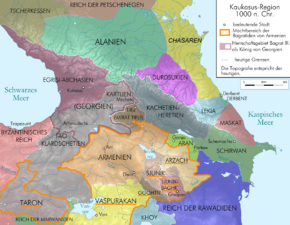Kingdom of Artsakh
Topic: History
 From HandWiki - Reading time: 2 min
From HandWiki - Reading time: 2 min
Kingdom of Artsakh | |||||||||
|---|---|---|---|---|---|---|---|---|---|
| 1000–1261 | |||||||||
 Syunik as vassal of the Armenian kingdom around 1000 | |||||||||
| Capital | Khachen, Haterk, Vaykunik | ||||||||
| Common languages | Armenian | ||||||||
| Religion | Armenian Apostolic | ||||||||
| Government | Monarchy | ||||||||
| King | |||||||||
| History | |||||||||
• Established | 1000 | ||||||||
• Subdivision of the kingdom | 1182 | ||||||||
• Acquisition of Dizak and Gardman | 1261 | ||||||||
• Assassination of Hasan Jalal, last king of Syunik | 1261 | ||||||||
| |||||||||
The Kingdom of Artsakh (Armenian: Արցախի թագավորություն) was a medieval dependent Armenian kingdom on the territory of Syunik and Artsakh provinces, Gardman canton of Utik province, Mazaz and Varazhnunik canton of Ayrarat province.[1] Contemporary sources referred to it as the Khachen. However, because the domain of Khachen during the reign of Prince Hasan Jalal included the entire territory of the modern Nagorno Karabakh Republic plus many contiguous lands to its west, south and north, his principality was often called the Kingdom of Artsakh.[2] The royal [3]
house of Khachen was a cadet branch of the ancient Syunid dynasty and was named Khachen, after its main stronghold. Hasan-Jalal traced his descent to the Armenian Aranshahik dynasty, a family that predated the establishment of the Parthian Arsacids in the region.[4]
Artsakh maintained its sovereign rulers, though in the early 13th century they accepted Georgian, then Mongol suzerainty.[5] They lost the royal title after the assassination of Hasan-Jalal (1214–1261) by the Ilkhanid ruler Arghun, but continued to rule Syunik as a principality, which from the 16th century comprised five Armenian melikdoms of Artsakh and Kashatagh melikdom of Syunik which lasted until the early 19th century.[1]
References
- ↑ 1.0 1.1 Hewsen, Robert H (2001). Armenia: A Historical Atlas. Chicago: University of Chicago Press. pp. 118–121. ISBN 0-226-33228-4.
- ↑ Hewsen, Robert H. “The Kingdom of Artsakh,” in T. Samuelian & M. Stone, eds. Medieval Armenian Culture. Chico, CA, 1983
- ↑ Hewsen, Robert H. “The Kingdom of Artsakh,” p. 47
- ↑ Ulubabyan, Bagrat (1975) (in hy). Խաչենի իշխանությունը, X-XVI դարերում [The Principality of Khachen, From the Tenth to Sixteenth centuries]. Yerevan: Armenian Academy of Sciences. pp. 56–59.
- ↑ Hewsen, Robert H. "The Meliks of Eastern Armenia: A Preliminary Study." Revue des Études Arméniennes. NS: IX, 1972, pp. 255-329.
Further reading
- Akopyan, Alexander V. (2015). "On the earliest coins of Khachen (Qarabagh)". Journal of the Oriental Numismatic Society 222: 6–11. https://www.academia.edu/10287188.
- Robert H. Hewsen. "The Kingdom of Arc'ax" in Medieval Armenian Culture (University of Pennsylvania Armenian Texts and Studies). Thomas J. Samuelian and Michael E. Stone (eds.) Chico, California: Scholars Press, 1984. ISBN:0-89130-642-0.
 |
 KSF
KSF
